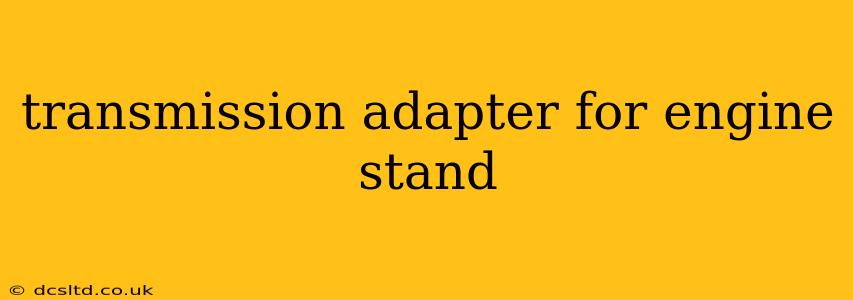Working on engine rebuilds or repairs often requires a sturdy engine stand. But what about the transmission? Leaving it dangling can lead to damage or make the job unnecessarily difficult. This is where a transmission adapter for your engine stand becomes invaluable. This comprehensive guide will explore everything you need to know about these essential tools, helping you choose the right one for your needs.
What is a Transmission Adapter for an Engine Stand?
A transmission adapter is a specialized attachment designed to securely mount a transmission to an engine stand. This allows you to work on the transmission independently or as a complete engine/transmission assembly with greater stability and ease. They come in various designs to accommodate different transmission types, sizes, and mounting points. Essentially, it provides a safe and stable platform to support the weight of the transmission during disassembly, inspection, repair, or rebuilding.
Why Use a Transmission Adapter?
Using a transmission adapter offers several key advantages:
- Enhanced Safety: Prevents the transmission from shifting, tilting, or falling, reducing the risk of injury or damage to the transmission itself.
- Improved Accessibility: Allows for easier access to all components of the transmission, simplifying repair and maintenance.
- Better Stability: Provides a secure and stable working platform, improving the overall efficiency and precision of the work.
- Ergonomics: Reduces strain and fatigue on the technician, leading to a more comfortable and productive work environment.
- Protection: Protects the transmission casing from damage during the repair process.
What Types of Transmission Adapters are Available?
Transmission adapters come in a variety of styles, each designed to suit different transmission types and engine stand designs. Common types include:
- Universal Adapters: These offer adaptability to various transmission sizes and configurations, often utilizing adjustable mounting points. They are generally more versatile but may require some additional setup and adjustment.
- Specific Adapters: Designed for particular transmission models or families (e.g., a specific GM automatic transmission). These offer the most secure and precise fit, eliminating the need for adjustments.
- Plate-Style Adapters: Usually flat plates with pre-drilled holes, offering multiple mounting options. They tend to be more versatile but may require more adaptation for proper fit.
- Clamp-Style Adapters: Use clamps to secure the transmission, offering a simple and effective solution. However, they might not be suitable for all transmission types.
Choosing the right type depends on the specific transmission you're working on and the engine stand you're using. Always check compatibility before purchasing.
How to Choose the Right Transmission Adapter?
Selecting the appropriate transmission adapter requires careful consideration of several factors:
- Transmission Type: Automatic, manual, size, and specific model (make, model, year).
- Engine Stand Compatibility: Ensure the adapter's mounting points match your engine stand.
- Weight Capacity: Choose an adapter with a weight capacity exceeding the transmission's weight.
- Material and Construction: Look for durable materials like steel for longevity and safety.
- Ease of Use: Consider the adapter's design and how easily it attaches and adjusts.
Reading reviews from other users can provide valuable insights before making a purchase.
How to Use a Transmission Adapter?
The specific steps for using a transmission adapter will vary depending on the adapter's design and the transmission type. However, the general process usually involves:
- Securely Mount the Adapter: Attach the adapter to the engine stand following the manufacturer's instructions.
- Align the Transmission: Carefully position the transmission on the adapter, ensuring proper alignment.
- Secure the Transmission: Tighten the bolts or clamps to securely fasten the transmission to the adapter.
- Double-Check Stability: Inspect the setup to ensure the transmission is securely mounted and stable.
Always follow the manufacturer's instructions carefully to avoid damage or injury.
What are the Common Mistakes to Avoid When Using a Transmission Adapter?
- Improper Alignment: Incorrect alignment can lead to damage to the transmission or the adapter.
- Over-Tightening: This can strip bolts or damage the transmission.
- Ignoring Weight Capacity: Using an adapter with insufficient weight capacity can lead to instability and accidents.
- Using an Incompatible Adapter: Using the wrong adapter can be dangerous and ineffective.
Paying close attention to detail will help ensure a safe and productive repair or rebuilding process.
This detailed guide should help you confidently choose and use a transmission adapter, improving your engine repair and rebuild projects. Remember always to prioritize safety and follow manufacturer instructions carefully.
